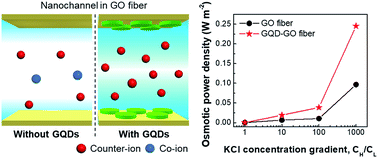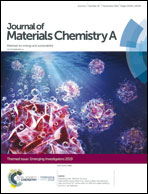Graphene quantum dots/graphene fiber nanochannels for osmotic power generation†
Abstract
Over the past few years, several nanofluidic channels have been constructed using ion-conductive materials. However, the design and fabrication of surface-charge-controllable nanochannels remain a scientific as well as a technological challenge. This study investigated the feasibility of graphene oxide (GO)-based fiber-type nanochannels for generating electrical energy by converting the salinity gradient. Owing to their large lateral size and the localized charged species on the edge, the low charge density of the GO fibers remains a critical bottleneck in their wider investigation. To address this critical issue, highly negatively charged and extremely small (2.42 ± 0.38 nm) graphene quantum dots (GQDs) were synthesized and intercalated through the interstitial network of GO sheets in fibers. With the application of GQDs, the charge density was significantly increased to 1.12 mC m−2 so that the ion conductance was enhanced to an average of 21 nS and the electrical energy generation was 0.25 W m−2. This study presents a facile and novel approach of enhancing ion selectivity and ion conductivity of graphene-fiber based miniaturized nanofluidic channels, proving their potential for osmotic energy generation and efficiency.

- This article is part of the themed collection: Journal of Materials Chemistry A Emerging Investigators


 Please wait while we load your content...
Please wait while we load your content...